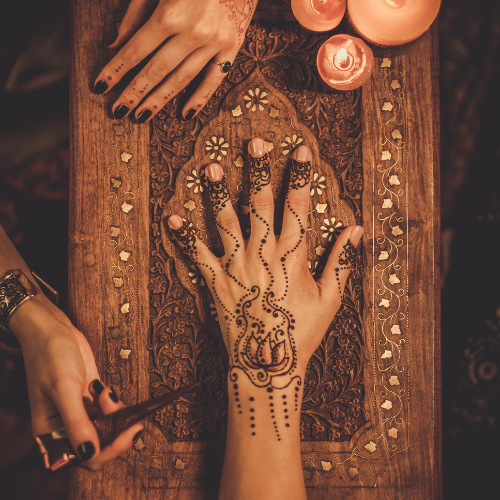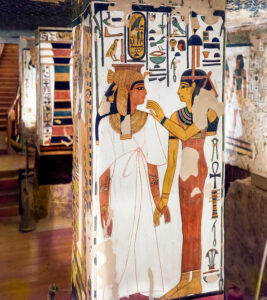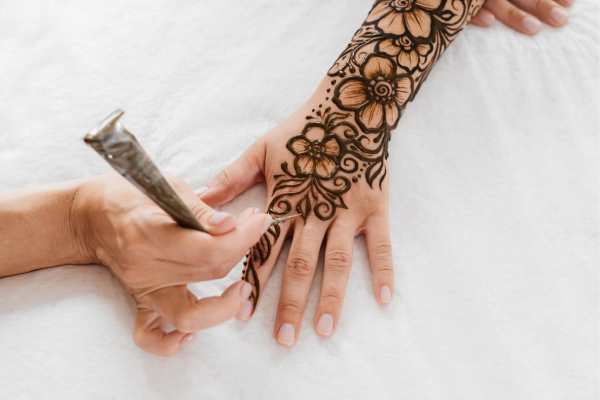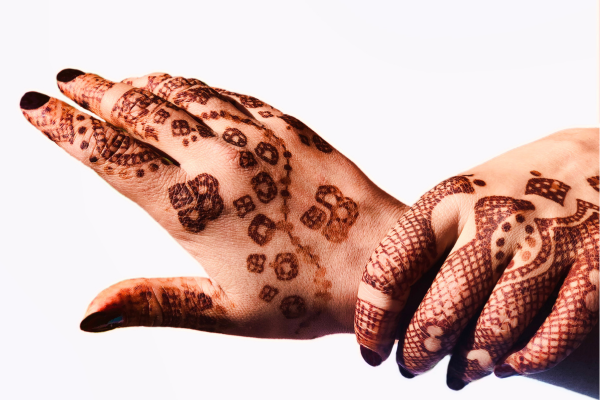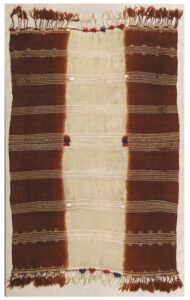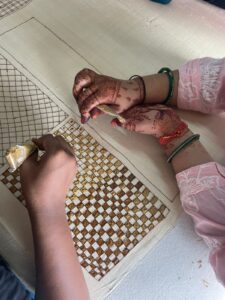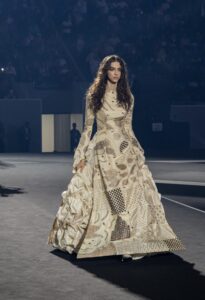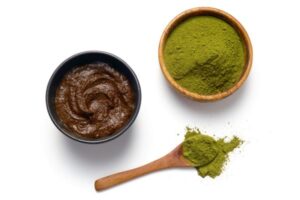Henna is a plant that has woven a vibrant and colourful thread through the tapestry of human civilization, connecting generations across the millennia. From ancient times to the present day, it has held a significant place in many cultures, playing a role in both everyday life and special occasions and rituals.
For centuries, henna has been a cherished symbol of beauty, health, and happiness. It has been used for body art, hair dyeing, and as a natural remedy for various ailments. It has been an essential element in traditional ceremonies such as weddings, births, and religious festivals.
The ancient roots of Henna
Known by various names around the world; hina, the mignonette tree, and Egyptian privet. In Arabic, it is known as حِنَّاء (ḥinnā’), while Hindi and Urdu speakers call it मेहंदी (mehndi) and مہندی (mehndī), respectively. Lawsonia inermis is the scientific name of the flowering plant that belongs to the Lythraceae family.
The henna plant, a wild shrub commonly found in uncultivated or abandoned areas, is believed to have originated in the hot, arid regions of North Africa, the Middle East and South Asia. Its usage can be traced back thousands of years to ancient civilizations in Egypt, Mesopotamia, and India among other regions.
Henna’s use can be traced back to the Bronze Age (circa 2100-1500 BCE). One prominent piece of archaeological evidence can be found in the tomb of Queen Nefertari, located in the Valley of the Queens in Egypt. Nefertari was the chief wife of Pharaoh Ramesses II and lived during the 19th Dynasty (circa 1292–1189 BCE). Her tomb, known as QV66, is one of the most elaborate and well-preserved tombs in the Valley of the Queens. The paintings in the tomb depict her hands and feet adorned with intricate henna patterns. In addition to the visual evidence of henna’s use for cosmetic purposes in ancient Egypt, henna was found in other archaeological contexts, in the form of henna traces discovered in hair samples obtained from mummies. Reinforcing the notion that ancient Egyptians used henna to enhance their appearance whether it was by colouring their hair or beautifying their skin.
Henna was also likely used in ancient Ugarit (modern-day Ras Shamra, Syria) between 1500-1200 BCE for various purposes. A late 13th-century BCE Ugaritic cuneiform tablet (KTU 4.767) contains the word “kprt,” which scholars believe refers to henna (kpr) as a medical prescription to treat pain.
The diverse applications of henna
Henna is produced and used in various regions, particularly the Middle East, North Africa, and South Asia, totalling up to about one-third of the world’s population.
Henna Body Art (naqsh_alhinnā)
For centuries, women in the Middle East, North Africa, and the Indian Subcontinent have mastered the intricate art of naqsh_alhinnā (drawing with henna). Henna body art is a form of temporary body decoration, as the designs created with henna typically fade away within a few weeks. Allowing people to enjoy the beauty and intricate designs of henna without the long-term commitment of a permanent tattoo.
The final colour of the intricate designs depends on the type of henna and the other ingredients mixed in the paste such as lemon juice, teas, and essential oils. Each design is unique and the possibilities are endless. Henna designs can be categorised into different themes that reflect the artist or customer’s vision, the occasion being celebrated and regional styles:
Geometric patterns
These intricate patterns boast a hypnotic quality, with their repetitive interlocking shapes and lines creating a visually striking and harmonious tapestry. These designs captivate the viewer, drawing them into a world of symmetry and balance.
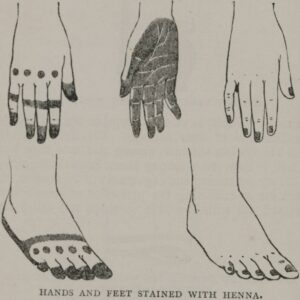
Henna patterns in Edward William Lane’s “Manners and Customs of the Modern Egyptians”, published in 1836 – VIA Henna by Sienna
Floral and nature-inspired motifs
Celebrating the beauty and wonder of nature, these enchanting designs incorporate flowers, leaves, and vines. They symbolise growth, the interconnectedness of life, and the ever-changing seasons, reminding us of the cyclical nature of existence.
Abstract and free-flowing designs
In these whimsical patterns, the henna artist unleashes their creativity and individuality. They playfully incorporate elements of traditional motifs.
Today, the term “henna tattoo” is commonly used to refer to this form of skin adornment, henna tattoos have become a beloved cultural exchange tool, with public figures and celebrities alike embracing it as a means of honouring traditions, promoting cross-cultural understanding and a symbol of good luck. Both Catherine, Princess of Wales, and Meghan, Duchess of Sussex, received henna tattoos while on official engagements during their pregnancies, showcasing the beauty of the art form and its significance in different cultures. Celebrities such as Madonna, Gwen Stefani, and Prince have incorporated henna art into some of their performances. In 2017, American singer Beyoncé commissioned a custom henna art for her belly to celebrate her pregnancy, featuring the lotus flower which symbolises transcendence, growth and the dots which represent a new life.
View this post on Instagram
Currently, UAE-based Azra Khamissa of @dr.azra is reimagining henna body art. With her contemporary designs, Khamissa reinterprets traditional ornate floral patterns as minimalist line drawings of individual flowers and replaces intricate mandalas with basic geometric shapes. Her distinctive designs blend traditional North African and Arabic motifs with her innovative ideas, including topographical outlines, abstract desert landscapes, and Arabic words, creating a style that is both timeless and cutting-edge. And the best part? Azra has developed stencil stickers that allow people to create their own henna tattoos. This modern take on henna in design and application not only revolutionizes the art form but also empowers individuals to use it as a medium for self-expression.
View this post on Instagram
Henna hair dye
To create the dye, henna leaves are meticulously harvested, dried, and then ground into a fine powder. The henna plant releases an earthy scent once it has been powdered. The powder is mixed with a mildly acidic liquid, such as lemon juice or tea, to release the lawsone pigment. The resulting paste is then applied to hair, skin, or nails, where it binds to the keratin proteins and imparts a reddish-brown colour.
Interestingly, the use of henna was once banned by the Spanish Inquisition due to its association with Muslim culture. However, by the 1800s, European women began to embrace henna as hair dye. According to Victoria Sherrow’s, “Encyclopedia of Hair: A Cultural History,” the famous opera singer Madame Adelina Patty (1843 -1919) is credited with popularizing henna hair dye in Europe during the late 1800s. Known for her long, thick, auburn hair, Patty used henna to attain her trademark hair colour and to cover grey hairs as she continued to perform until 1906. Since then, more European and American women turned to henna imported from The Middle East and India.
Even today, henna is preferred by many as a healthy alternative to synthetic dyes. Renowned fashion designer, Diane von Furstenberg is a big fan of henna dye, stating in an interview with Vogue, “I always did henna, and as a result, I have very healthy hair at my age.” With its natural properties, free from harmful chemicals and gentle on the skin, it’s no wonder henna remains a beloved and timeless beauty practice.
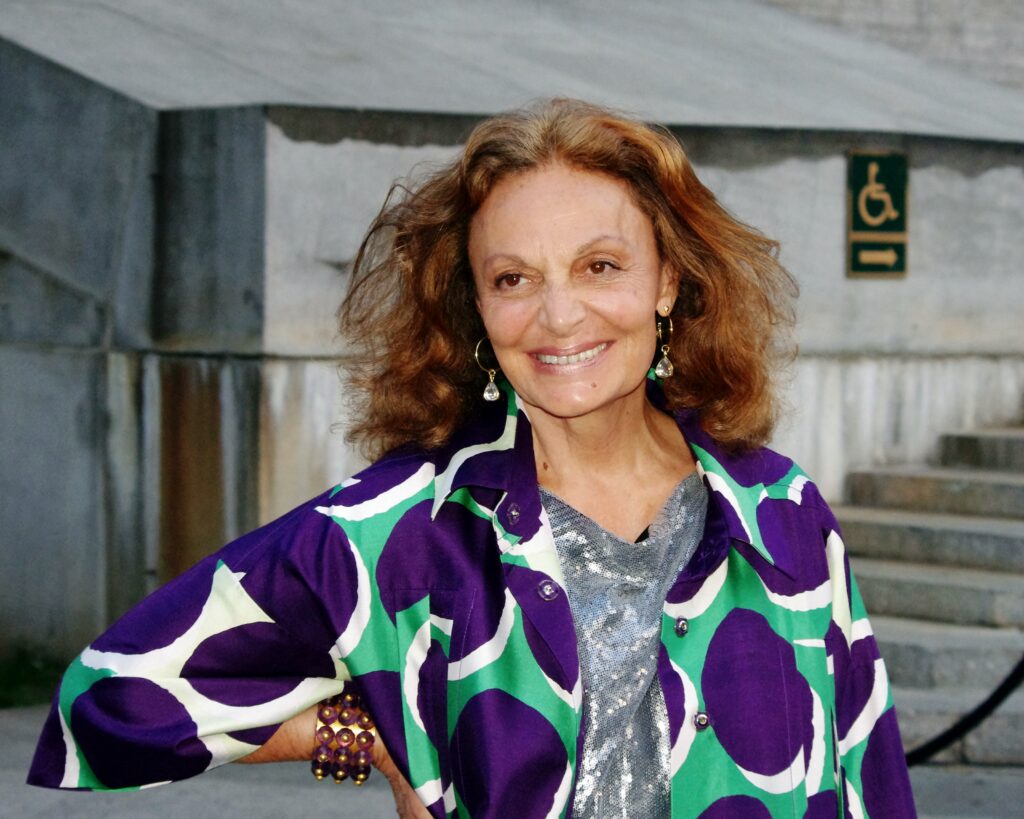
Designer Diane von Furstenberg revealed that she only uses henna to dye her hair. Image: Wikicommons
Henna as a textile dye
While not as popular or widely used as other natural dyes such as indigo or madder, henna has been employed in the creation of remarkable textiles. In the Anti-Atlas region of Morocco, the Chleuh Amazigh women use henna to create unique symbols on their textiles, imbuing them with baraka or “blessing power”. These talented women produce henna-dyed cloths primarily for personal use rather than trade or commercial purposes, including head covers, veils, and wedding blankets.
The artistic application of henna allows the Amazigh women to express their creativity and individuality. Their design styles are influenced by Neolithic and Libyo Amazigh rock carvings in Tagragra, Morocco, which encompass bold geometric patterns, figurative designs, and scripts. This connection to ancient art forms lends an air of timelessness to the henna-dyed textiles.
A testament to their enduring appeal, a wedding headscarf from the first half of the 20th century can be viewed at the Saint Louis Art Museum. Morocco-based artist Sonja Georgeson’s blog features a detailed post illustrating the intricate dyeing process practiced by Mina, a resident of the Draa Valley, Morocco, who still uses henna to dye wool, providing a first-hand look into the lasting beauty of this art form.
It is inspiring to see contemporary designers, like Mashael Alnaimi, recognize the value of these traditional practices and incorporate them into their designs. Furthermore, the increasing interest of late, in sustainable fashion has shed light on the beauty of natural dyes and their potential to replace harmful synthetic alternatives.
When Qatari designer, Mashael Alnaimi participated in the 2022 Zwara M7 design program, she was selected to develop a look inspired by Christian Dior. “I was the oldest participant at 53 and the least experienced with only 2 years. I felt that I had to come up with something that would stand out,” says the designer behind @mhefhef.
Mashael Alnaimi’s henna-dyed look, inspired by Christian Dior, courtesy of the designerMashael decided to experiment with henna dye. Her decision, however, was not without risks, “I thought of different local plants, but henna was my favourite albeit risky since it wasn’t used as a dye on silk before, I wasn’t sure what to expect,” but her passion for sustainability drove her to explore the use of local flora to dye fabrics. “We need to experiment with local flora to make and dye fabrics, it’s sustainable, eco-friendly, inexpensive, safe and also beautiful” Mashael adds.
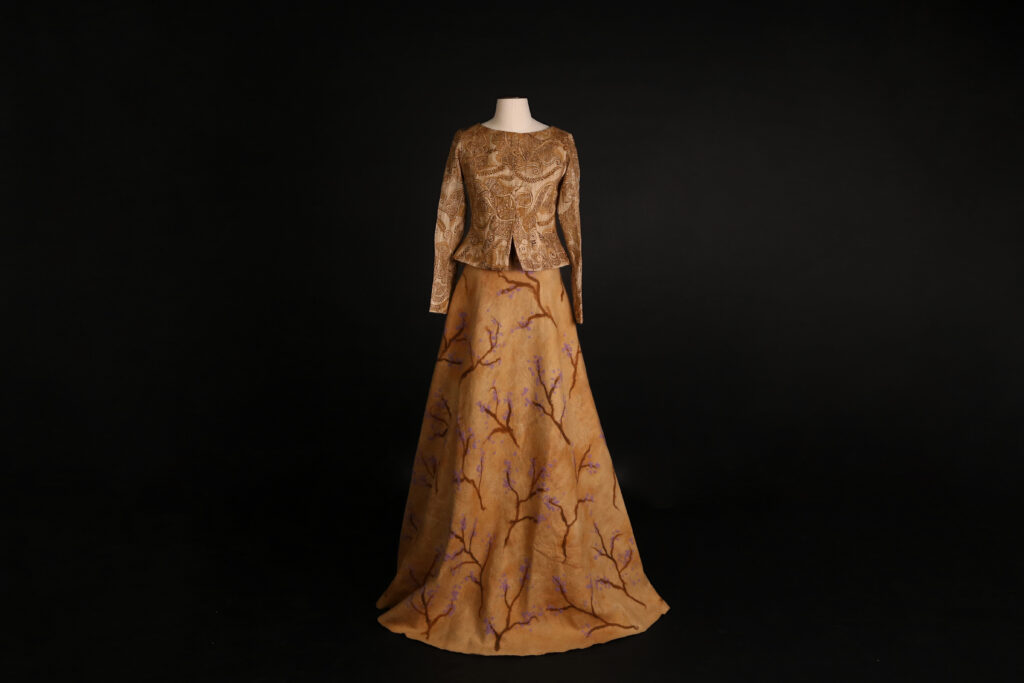
Mashael Alnaimi’s creation for 2022 Zwara M7 design, inspired by Christian Dior and dyed with henna. Courtesy of the designer
According to the designer, Henna dye not only produces an imposing 3D effect on silk but is also delicate and more of an art than a practical everyday piece. Mashael’s henna jacket, inspired by Christian Dior, was showcased at Zwara exhibition and the reactions were so encouraging that Mashael decided to develop permanent henna paint.
Later in 2022, Mashael was selected to showcase a dress at the Qatar Fashion United by CR Runway, when she developed a permanent henna dye for silk fabrics. “I can’t think of any other dye that is quintessentially celebratory. It’s meant to be used to happy occasions, Eid, weddings. It’s the fairy lights of dyes,” Mashael remarks.
In November 2022, Sheikha Moza of Qatar wore the first abaya made with this technique to one of the World Cup games, catapulting Mashael’s work onto a global stage. Mashael plans to keep developing her techniques with henna to make eco-friendly luxury clothing for her brand, mhefhef.
View this post on Instagram
Mashael’s innovative use of henna dye on silk adds a unique aesthetic to her pieces and showcases her exceptional creativity and talent. She also serves as an inspiration to other designers in the fashion industry to explore and embrace sustainable alternatives to conventional materials and methods.
The medicinal properties of henna
Traditionally, henna has been used to treat various ailments ranging from headaches, fevers, digestive issues, skin infections and even jaundice!
Thanks to modern-day scientific advancements we now have a deeper understanding of the incredible properties that the henna plant possesses. The natural properties of henna include antimicrobial and anti-inflammatory effects, for example, fresh henna leaves can be used to treat fungal or bacterial infections. Dried henna leaves were also placed in clothing to repel bugs.
Additionally, the natural cooling properties have made it useful for soothing overheated skin in hot climates. When applied as a paste on the skin, it provides a cooling sensation, offering relief from heat and discomfort, and making it a popular remedy for treating sunburn and other heat-induced skin irritations.
At present, innovators in different disciplines are looking at henna with renewed enthusiasm. Several studies suggested henna’s anticancer potential. Although more research is needed to confirm these findings, it is exciting to think that this beautiful plant may have even more health benefits to offer. It is possible that we have only scratched the surface when it comes to understanding the full range of medicinal properties that henna possesses. As researchers continue to study this miraculous plant, we may discover even more ways to harness its power for the benefit of human health.
While we have covered some of the essential aspects of henna and its use, in this blog, there is still so much to explore. In part two of this series, we will delve deeper into the cultural significance of henna in various countries and its role in different celebrations and traditions. By understanding henna’s role in various cultures and contexts, we can appreciate its beauty and significance on a deeper level. Stay tuned for part two, where we will continue our journey into the world of henna.
Further reading:
- The Colour of Henna: Painted Textiles From Southern Morocco African Textiles: Colour and Creativity Across a Continent”, by John Gillow
Sources:
- Amazigh textiles and dress in Morocco: metaphors of motherhood – Cynthia Becker
- Henna Cloth – Sarah Corbett
- Henna’s Secret History: The History, Mystery & Folklore of Henna – Marie Anakee Miczak
- Henna Art in Global Era: From Traditional to Popular Culture – Baiq Clara Dita Chairunnisa
- The New Ottoman Henna Nights and Women in the Palace of Nostalgia – Petek Onur
- Encyclopedia of Hair A Cultural History By Victoria Sherrow
- Lawsonia inermis (L.): A perspective on anticancer potential of Mehndi/Henna
- A Botanical Snapshot of Ugarit. Trees, fruit, plants and herbs in the cuneiform texts – Wilfred G. E. Watson
